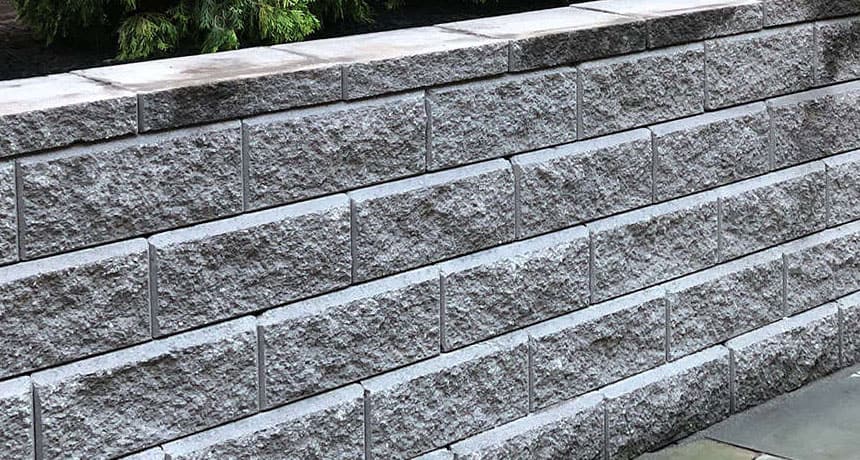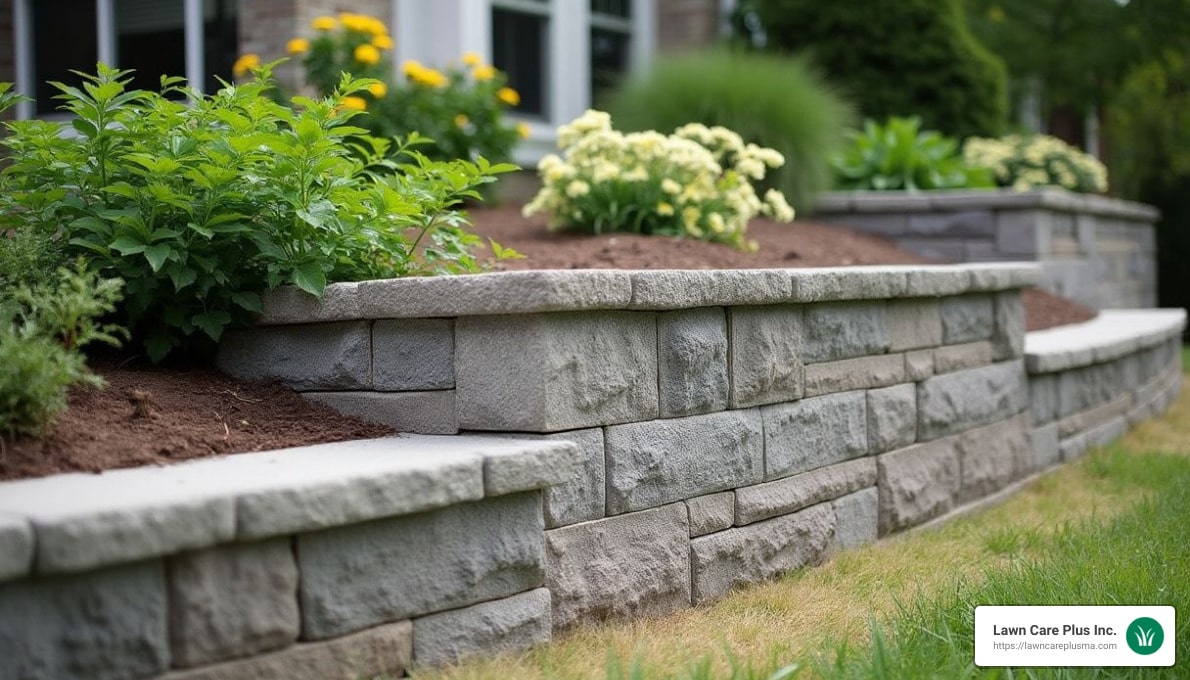Why Choose Concrete Retaining Wall Blocks
Concrete retaining wall block is a popular choice among homeowners and property managers looking for a blend of durability, functionality, and aesthetic appeal. These blocks come in various shapes, sizes, and colors, allowing you to create walls that not only serve a purpose but also improve the visual charm of your landscape.
Overview at a Glance
- Durability: Concrete retaining wall blocks can last 50-100 years.
- Design Flexibility: Available in natural color blends and textures like tumbled stone, stacked stone, and more.
- Usage: Ideal for addressing uneven ground, preventing soil erosion, and creating terraced landscapes.
Concrete retaining wall blocks effectively hold back soil and manage steep slopes, while also offering a customizable design element to any outdoor space. Whether you need to stabilize an area prone to erosion or want to create a visually striking landscape feature, these blocks are versatile and reliable.
By choosing concrete retaining wall blocks, you are investing in a long-lasting solution that improves both the function and appearance of your property. Let’s dig deeper into the types, benefits, and installation techniques to help you make an informed decision for your next project.

Concrete retaining wall block word list:
– block retaining wall
– concrete block retaining wall
Types of Concrete Retaining Wall Blocks
When it comes to choosing the right concrete retaining wall block for your project, understanding the different types available can help you make an informed decision. Each type offers unique benefits, from cost-effectiveness to durability and ease of installation. Here’s a closer look at the main types:
Poured Concrete
Poured concrete walls are a solid choice for those seeking cost-effectiveness and strength.
Materials and Sizes: Poured concrete requires a mix of cement, sand, gravel, and water. The size and shape of the wall are determined by the molds used during the pouring process.
Cost-effectiveness: While the initial cost can be higher due to labor and materials, poured concrete walls are durable and require minimal maintenance, making them a cost-effective option in the long run.
Installation: Installing poured concrete walls involves creating a formwork, pouring the concrete, and allowing it to cure. This method is labor-intensive and typically requires professional expertise.
Interlocking Concrete Blocks
Interlocking concrete blocks offer a blend of strength, support, and durability.
Materials and Sizes: These blocks are made from high-density concrete and come in various sizes. They are designed to fit together like puzzle pieces, providing strong structural support.
Strength and Support: The interlocking design helps distribute weight evenly, making these blocks ideal for retaining walls that need to support significant loads.
Durability: Interlocking blocks are resistant to weather conditions and erosion, ensuring a long-lasting solution for your landscape.
Installation: These blocks are relatively easy to install. They require a leveled base and can be stacked without the need for mortar, making them a popular choice for DIY projects.
Large Concrete Blocks
Large concrete blocks are perfect for heavy-duty applications where size and weight are crucial.
Dimensions and Weight: These blocks are typically 2’x2’x4′ and weigh around 2,000 lbs. Smaller variants, like half blocks, are also available.
Cost: The cost of large blocks can vary. For example, a large block might cost around $125, while a smaller half block could be $63. These prices reflect the substantial material and shipping costs due to their weight.
Installation: Installing large concrete blocks often requires heavy machinery due to their size and weight. This makes them more suitable for professional installation rather than DIY projects.
In summary, whether you choose poured concrete for its seamless look, interlocking blocks for their ease of installation, or large blocks for heavy-duty applications, each type of concrete retaining wall block offers distinct advantages. Understanding these options will help you select the best material for your specific needs.
Benefits of Using Concrete Retaining Wall Blocks
Concrete retaining wall blocks offer a range of benefits that make them an excellent choice for various landscaping projects. Let’s explore the key advantages:
Durability and Strength
Weather Resistance: Concrete retaining wall blocks are incredibly durable and can withstand harsh weather conditions. Whether it’s heavy rain, snow, or extreme heat, these blocks remain intact and functional.
Load-Bearing Capacity: These blocks are designed to support significant loads. Their robust structure ensures that they can hold back soil and resist pressure from water runoff, making them ideal for retaining walls that require strong support.
Longevity: With proper installation and maintenance, concrete retaining wall blocks can last for decades. They are resistant to rot, pests, and other elements that typically degrade other materials like wood.
Design Flexibility
Customization: Concrete retaining wall blocks come in various shapes, sizes, and colors. This allows for a high degree of customization to match the aesthetic of your landscape. You can choose from finishes that mimic natural stone, tumbled stone, or even chiseled stone.
Visual Appeal: These blocks can improve the visual appeal of your outdoor space. Whether you want a modern look or something more rustic, there are options to suit every style. Built-in planters, seating walls, and fire pits can also be integrated using these versatile blocks.

Functionality: Beyond aesthetics, concrete retaining wall blocks offer practical benefits. They can help in leveling out uneven ground, creating usable outdoor spaces, and improving drainage.
Environmental Considerations
Sustainability: Many concrete retaining wall blocks are made from recycled materials, making them an eco-friendly choice. The production process for these blocks often involves less energy and fewer natural resources compared to other materials.
Recyclability: At the end of their life cycle, concrete blocks can be recycled and repurposed. This contributes to a circular economy and reduces the environmental impact of your landscaping project.
In summary, concrete retaining wall blocks provide a durable, flexible, and environmentally friendly solution for your landscaping needs. Whether you’re looking to improve the functionality of your yard or improve its visual appeal, these blocks offer a reliable and versatile option.
Installation Techniques for Concrete Retaining Wall Blocks
Proper installation is crucial for the longevity and effectiveness of your concrete retaining wall. Here’s a guide to ensure your project is a success:
Installation Techniques for Concrete Retaining Wall Blocks
Proper installation is crucial for the longevity and effectiveness of your concrete retaining wall. Here’s a guide to ensure your project is a success:
Foundation and Base Preparation
1. Site Preparation:
Start by clearing the area where the wall will be built. Remove any vegetation, rocks, or debris. This will give you a clean slate to work on.
2. Excavation:
Dig a trench for the foundation. The depth of the trench should be about one-tenth of the wall’s height. Make sure the trench is wide enough to accommodate the base material and the first layer of blocks.
3. Compacted Gravel Base:
Fill the trench with a layer of compacted gravel. This layer should be about 6 inches deep. Compact the gravel using a tamper to ensure a solid base. This step is crucial for stability and drainage.
4. Drainage:
Proper drainage is essential to prevent water from accumulating behind the wall, which can cause pressure and damage. Install a perforated pipe at the base of the trench, wrapped in filter fabric to keep out sediment.
Building and Aligning Blocks
1. First Course:
Place the first row of blocks on the compacted gravel base. Ensure they are level both front-to-back and side-to-side. This foundational row is critical for the stability of the entire wall.
2. Interlocking Blocks:
If you’re using interlocking concrete blocks, make sure each block fits snugly with the adjacent one. This interlocking mechanism adds strength and stability to the wall.
3. Backfill:
As you build each row, backfill with gravel behind the blocks. This helps with drainage and adds weight to the wall, enhancing its stability.
4. Precision Tools:
Use a level and a string line to ensure each row is straight and level. Precision is key to maintaining the structural integrity of the wall.
Finishing and Maintenance
1. Sealing:
Once the wall is built, consider applying a sealant to protect the blocks from moisture and stains. This will extend the life of the wall and keep it looking new.
2. Cleaning:
Regularly clean the wall to remove dirt, mold, and other debris. A simple solution of water and mild detergent can keep the blocks looking fresh.
3. Inspection:
Periodically inspect the wall for any signs of movement or damage. Addressing small issues early can prevent larger, more costly repairs in the future.

By following these steps, you can ensure that your concrete retaining wall block installation is both durable and aesthetically pleasing. Proper preparation, precise building techniques, and regular maintenance are key to a successful project.
Frequently Asked Questions about Concrete Retaining Wall Blocks
Is a concrete retaining wall cheaper than blocks?
When it comes to cost, concrete retaining wall blocks can be more affordable than poured concrete walls. The materials for blocks are generally cheaper, and the installation process is less labor-intensive, which can save you money on labor costs.
For example, using wood and masonry retaining wall blocks are among the cheapest options, with costs ranging from $1,000 to $2,300 for 100 square feet if you do it yourself. Professionally installed, the cost can rise to $2,200 to $4,000. This makes block walls a budget-friendly option for many homeowners.
What is the best block for a retaining wall?
Interlocking concrete blocks are often considered the best choice for retaining walls due to their durability and ease of use. These blocks fit together like puzzle pieces, providing superior strength and stability.
The interlocking design also makes them easier to install, which can be a big advantage if you’re doing the project yourself. These blocks are designed to bear heavy loads and withstand harsh weather conditions, making them ideal for both residential and commercial applications.
Can you build a retaining wall with concrete blocks?
Absolutely, you can build a retaining wall with concrete blocks. In fact, concrete blocks are one of the most popular materials for DIY retaining wall projects because they are easy to work with and don’t require specialized skills or tools.
Building a retaining wall with concrete blocks can be time-efficient, especially if you use interlocking blocks. These blocks stack easily and require minimal mortar, making the construction process quicker. Plus, they offer flexibility in design, allowing you to create various shapes and heights to suit your landscape needs.
By understanding the cost, material options, and ease of use, you can make an informed decision about using concrete retaining wall blocks for your next project.
Conclusion
In summary, concrete retaining wall blocks offer a versatile and cost-effective solution for enhancing your landscape. Their durability, ease of installation, and design flexibility make them an excellent choice for both residential and commercial projects. Whether you’re dealing with sloping ground, erosion issues, or simply want to add visual interest to your yard, these blocks provide a reliable and aesthetically pleasing option.
At Lawn Care Plus Inc., we specialize in creating beautiful and functional landscapes using high-quality materials like concrete retaining wall blocks. Serving the Boston Metro-West area, our experienced team is dedicated to delivering exceptional craftsmanship and personalized service to meet your unique needs.
If you’re ready to transform your outdoor space with a retaining wall or other landscaping features, contact us today to get started. Let us help you create a landscape that not only looks stunning but also adds value and functionality to your property.

